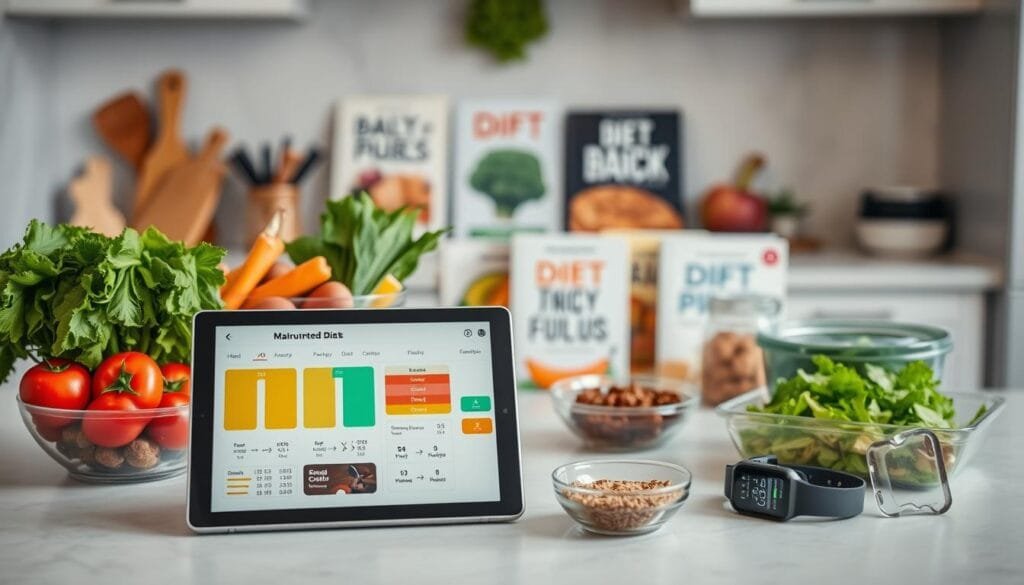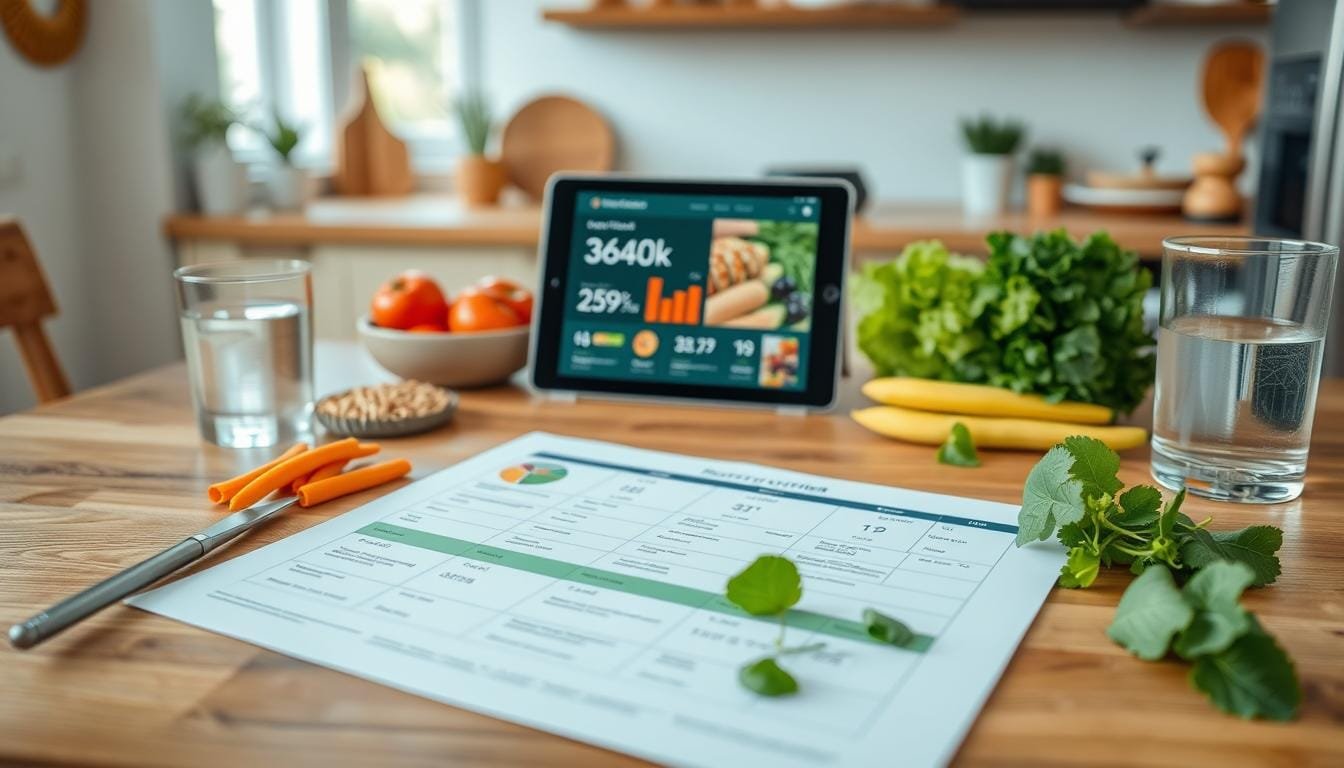Meal planning never excited me until I discovered personalized eating. It was a game-changer for my weight and health goals. Generic diets didn’t work, but a tailored approach made all the difference.
That’s when I started learning how to find a meal plan that works for you. I explored apps like Eat This Much for customized meal plans. These plans consider preferences, budget, and schedule. I enjoyed my meals more and saw real progress.
Finding the right meal plan is about understanding your body and lifestyle. It’s not about following trends. It’s about creating a sustainable approach to eating.
The Eat This Much app has over 21,000 reviews. More than 9,000 users report satisfaction. Some have lost up to 40 pounds with their personalized plans.
Technology makes personalized eating more accessible. Meal planning services use complex algorithms to create tailored weekly menus. They consider over fifty data points for each user.
These services even connect with grocery delivery. This makes sticking to your plan easier than ever.
Key Takeaways
- Personalized meal plans cater to individual dietary needs and preferences
- Users report significant weight loss and improved health with customized eating plans
- Advanced algorithms consider multiple factors to create tailored weekly menus
- Integration with grocery delivery services enhances convenience and adherence
- Customized plans can accommodate various dietary styles, from vegan to paleo
- Personalized approaches help reduce food waste and save money
Understanding the Fundamentals of Personalized Nutrition
Personalized nutrition tailors your diet to your unique needs. It goes beyond general guidelines to optimize your health. Let’s explore the core elements of this approach.
Role of Individual Dietary Needs
Everyone’s body has different nutrition needs. Age, gender, health conditions, and fitness goals shape these requirements. People with obesity face higher risks of type 2 diabetes and heart disease.
This highlights why customized nutrition plans are so important. Your body’s specific needs guide your ideal diet.
Impact of Lifestyle on Meal Planning
Your lifestyle greatly influences your eating habits. Work schedule, activity level, and family dynamics affect what and when you eat. Studies show 70% of people report better health with personalized meal plans.
Aligning your diet with your lifestyle is key to long-term success. It makes healthy eating more manageable.
Importance of Personal Food Preferences
Including foods you love makes your meal plan more enjoyable. This increases the likelihood of sticking to your diet. 60% of people prefer sustainable and enjoyable meal plans.
A diverse diet supports gut health and healthy body weight. It also protects against chronic diseases.
Consider your nutrition needs, lifestyle, and food preferences when creating your eating plan. This personalized approach works better than one-size-fits-all diets. It suits your unique needs and tastes.
Popular Eating Styles and Their Customization Options
Customizable diet plans help you find a nutrition approach that fits your lifestyle. Let’s explore popular diets and how to tailor them to your needs.

Mediterranean Diet Adaptations
The Mediterranean diet boosts heart health. It focuses on fish, nuts, legumes, fruits, and vegetables. This diet can fit different cultural preferences or dietary restrictions.
Low-Carb and Keto Variations
Low-carb diets, including keto, can be adjusted for your goals and carb tolerance. A “Healthy Keto” plan might allow about 50 grams of net carbs daily.
This offers more flexibility than strict keto approaches.
Plant-Based Diet Modifications
Plant-based diets suit vegetarians, vegans, and flexitarians. These eating styles can ensure enough protein intake. Protein sources include beans, soy, eggs, and dairy.
Paleo and Whole Foods Approaches
Paleo and whole foods diets focus on unprocessed ingredients. These approaches can fit modern lifestyles. They maintain the core idea of eating natural, nutrient-dense foods.
| Diet Type | Key Features | Customization Options |
|---|---|---|
| Mediterranean | Fish, nuts, legumes, fruits, vegetables | Cultural adaptations, dietary restrictions |
| Low-Carb/Keto | Reduced carbohydrate intake | Adjustable carb levels, “Healthy Keto” variations |
| Plant-Based | Focus on plant-derived foods | Vegetarian, vegan, flexitarian options |
| Paleo/Whole Foods | Unprocessed, natural ingredients | Modern lifestyle adaptations |
Success with any diet means finding a plan you can stick to. Customizable diets let you create an eating style that matches your tastes and goals.
How to Find a Meal Plan That Works for You

The right meal plan can transform your health and lifestyle. A personalized approach is crucial for success. Let’s explore steps to help you choose the perfect nutrition plan.
Start by evaluating your eating habits and health goals. Are you aiming to shed pounds or manage a health issue? This reflection is vital for selecting a suitable plan.
Next, look into various eating styles. Mediterranean, low-carb, plant-based, and paleo diets all have unique perks. Many people prefer flexible plans, so feel free to mix things up!
- Research meal planning tools like MyPlate.gov’s personalized calculator
- Experiment with different cuisines and recipes
- Consider your schedule and cooking skills
- Factor in your budget and food preferences
Most folks find it easier to stick to plans with repeated meals. Try planning a few go-to dishes each week. Add variety with one or two new recipes.
This method can save time and reduce stress. Many meal planners report less anxiety about daily meal prep.
Finding your ideal meal plan takes time. Be patient and stay flexible. Don’t be afraid to make changes as you go.
Tools and Technologies for Meal Planning Success
Digital nutrition tools have transformed meal planning. They cut planning time from 10 hours to just 30 minutes. This helps busy people eat healthier with less effort.
Digital Meal Planning Apps
Smart apps create meal plans based on calories, macros, and diet types. They have big food databases, so you don’t need to search for recipes. Users can swap recipes to match their likes and moods.
Smart Grocery List Management
Digital tools make automatic grocery lists, saving time and reducing waste. Some apps work with delivery services, making shopping easier. Use the 90:10 rule: 90% healthy foods, 10% treats.
Virtual Pantry Organization
Virtual pantry tools track what you have at home. They help avoid buying too much. These tools can suggest recipes using food you already have.
| Feature | Benefit |
|---|---|
| Automated Meal Plans | Reduces planning time to 30 minutes |
| Recipe Swapping | Increases user engagement |
| Integrated Grocery Lists | Streamlines shopping process |
| Virtual Pantry | Minimizes food waste |
Using these tools makes meal planning fun and easy. It becomes a nice part of living healthy.
Strategies for Reducing Food Waste and Cost
Food waste is a big problem. About 40% of food is wasted along the supply chain. Let’s look at ways to plan meals and shop wisely.
Check This:
- Customized Nutrition: How to Make a Meal Plan Based on Macros for Your Goals
- Budget-Friendly Fat Loss: Cheap Diet Meal Plan to Lose Weight Effectively
Inventory Management Techniques
Check your pantry before shopping. This can cut waste by up to 30%. Try using PlateJoy’s virtual pantry to track your food items.
Smart Shopping Strategies
Plan your meals to save on groceries. Families can save 15-20% by meal planning. Shopping sales can add 5-10% more savings.
The average family wastes $1,800 yearly on food that’s thrown away. That’s a lot of money going in the trash!
Meal Prep and Storage Solutions
Good meal prep and storage help reduce waste. Using leftovers can save time and money. Households can save 10-15% on food costs this way.
| Strategy | Potential Savings | Environmental Impact |
|---|---|---|
| Inventory Management | 30% reduction in food waste | Less methane from rotting food |
| Meal Planning | 15-20% on grocery bills | Reduced greenhouse gas emissions |
| Efficient Use of Leftovers | 10-15% on food costs | Less food in landfills |
These strategies can make a big difference. Food waste causes 2.6% of yearly greenhouse gas emissions in the U.S. Let’s work to lower this number through smart planning and shopping.
Maintaining Long-Term Success with Your Meal Plan
Sustainable meal planning is crucial for long-term nutrition success. Adapting eating habits gradually increases the likelihood of sticking to your plan. Let’s explore strategies that have proven effective for real people.
One person lost 35 pounds in a year using a personalized meal plan. They achieved this through a balanced approach. Their plan aimed for a modest 200-300 calorie deficit below their basal metabolic rate.
| Meal | Calories |
|---|---|
| Breakfast | 450 |
| Lunch | 400 |
| Snack | 350 |
| Dinner | 400 |
| Evening Snack | 200 |
| Total | 1,800 |
Flexibility is key to long-term success. Aim for 90% compliance with your meal plan. Allow for a couple of “cheat” meals each week. This balance helps maintain motivation without feeling deprived.
Sustainable meal planning goes beyond weight loss. It’s about creating a lifestyle that supports your health goals. Regularly reassess your plan and make small adjustments as needed.
This approach ensures your meal plan continues to work for you over time. Your needs may change, but your plan can adapt to keep you on track.
Conclusion
Personalized nutrition offers many benefits for your health and lifestyle. A custom meal plan helps you stick to your dietary goals. Tailoring your eating habits increases your chances of long-term success.
Stats show the power of personalized meal planning. 80% of regular planners maintain their dietary goals better. Meal planning can reduce grocery bills by 30%.
It also cuts food waste in half. This approach benefits your health, wallet, and the environment.
Creating a personalized nutrition plan is simple. Use the right tools and strategies for a sustainable plan. Consistency and flexibility are key to your success.
Digital apps or pen and paper can help you stay on track. Embrace a custom meal plan for better nutrition and overall well-being.
Source Links
- https://www.eatthismuch.com/ – The Automatic Meal Planner – Eat This Much
- https://www.platejoy.com/ – Custom Meal Plans & Meal Planning Recipes

